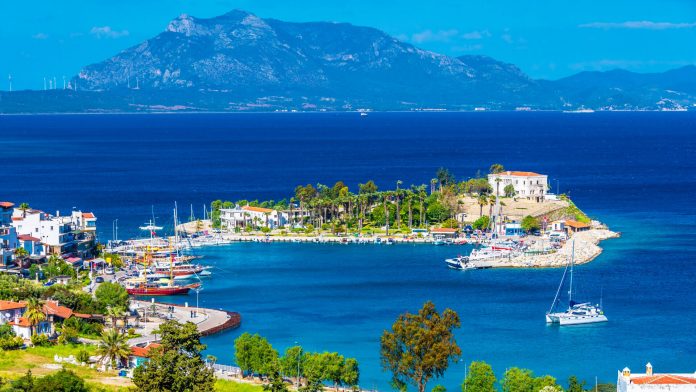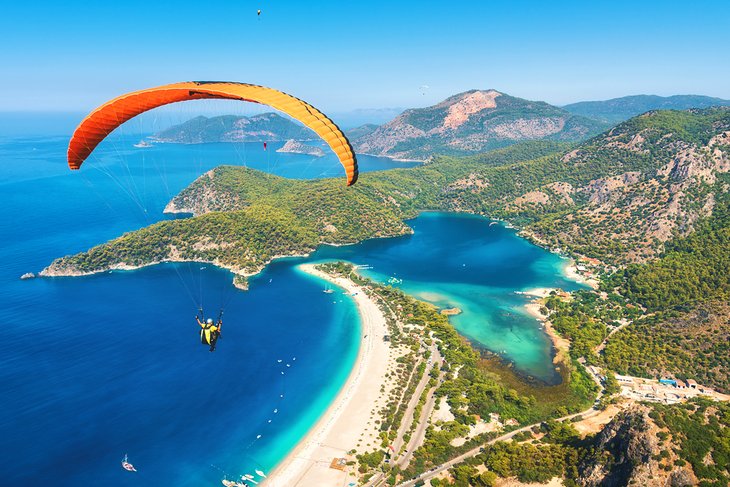Surrounded by the sea on three sides and a peninsula where the Mediterranean and the Aegean meet, Datça is one of the most unique holiday resorts on the south coast of Turkey. The 235 km coastline of the peninsula is adorned with indented and protruding coves, large and small, like lace. Sometimes surrounded by steep rocks, sometimes by beautiful beaches. There are exactly 52 bays. There are small islets in front of some of the bays. Some of the bays are quite large and have long sandy beaches, some are pebbly, but all are clean,
The Datça Peninsula is a large peninsula that starts from the narrowest part of the peninsula and extends from the port of Bencik to Knidos. The distance between Bencik port on the side facing the Hisarönü Gulf and Bördübet on the side facing the Gökova Gulf is as low as 800 meters in this narrowest place, which looks like it will break on the map.
There were even those who wanted to open this narrow place and turn Datça into an island. According to Herodotus, the father of history, after the Persians entered Ionia, the people of Knidos wanted to make their homeland an island by digging this narrow isth in Balıkaşiran. They made a lot of effort, but the peninsula resisted not to break away from the mainland. Incurable wounds began to appear all over the people who broke the stones, especially their eyes. They gave up on that.
Climate
Geography scholar Strabon said, “God sends his beloved servant to Datça Peninsula to live a long life.” This is not a word spoken in vain. According to a story told in the region: 4-5 hundred years ago, Spanish pirates decided to throw the leprosy patients on the ship while they were passing by Datça and left them in Sarıliman Bay. The lepers, who were left to die, were healed by the oxygen-rich air of Datça, and their wounds were healed. It is not known whether the story is true or not, but it is a fact that the air of Datça makes people healthy.
It is a paradise peninsula where you can have a holiday without sweating with its natural micro-climate feature and its clean air with plenty of oxygen, and where the winter season is almost never experienced. It is one of 100 points on the earth that urgently need protection, as determined by the World Environment Foundation in 1999.
Since the temperatures are between 12-14 degrees during the winter months, it actually has a long holiday period with its mild climate. Almond trees, which begin to bloom in January, greet spring standing as if wearing a wedding dress. Then colorful anemones bloom; you can see all the tones of blue, purple, white and pink. Mimosas, daisies, poppies create a riot of colors. With its rich flora and fauna, it allows many endemic plants to live.
The traditionally held Open Sea Swimming Marathon in mid-February since 2007 is also proof of its beautiful and mild climate.
Fisherman of Halicarnassus Cevat ŞAKİR “Climate in Datça is at full human height. Neither the heat nor the cold exceed the limits of human tolerance. How beautifully he described it by saying, “There is no way to fix the climate with a coat, a stove or a fan.”
Transportation
You can reach Datça by road via Marmaris. The distance between Marmaris and Datça is 70 km. There are regular minibus and bus services from Marmaris.
The distance between Dalaman Airport and Datça is 178 km in total. Between 1 June and 15 October from Dalaman airport, there are 4-6 mutual passenger transfers with non-scheduled flights.
Two reciprocal ferry services between Datça – Bodrum in the summer, in the low season, every day in the morning and in the evening; In high season, there are 4 mutual ferry services every day. The ferry ride takes about two hours. For ferry passengers, there is a shuttle bus between Datça and Körmen Port. In addition to passengers, bicycles, motorcycles, cars and caravans are also taken to the ferries. However, if you have a vehicle, you need to make a reservation in advance.
History
It is known that the finds on the Datça peninsula date back to 2000 BC. The first known indigenous people are the Snows. The heyday was during the Dors period. In 1000 BC, they came to the region via Greece by going south through Thrace. They established Knidos in the Burgaz region, 1.5 km northeast of today’s Datça center. Knidos became the center of the Doric civilization. After the Lydia state fell to the Persians in 546 BC, Knidos also came under Persian rule. The Dorians and Romans built many temples in the new Knidos. The city is famous for the statue of Aphrodite. In the Late Roman and Early Byzantine Periods, temples were replaced by churches. In the last periods of Byzantium, the city was completely abandoned as a result of earthquakes on the one hand and pirate attacks on the other.
The settlements on the peninsula were connected to the Menteşoğulları principality in the 13th century, and in the 15th century, they joined the borders of the Ottoman Empire and took the name Datça.
During the reign of Sultan Reşat, one of the last Ottoman sultans, the name Datça was changed to Reşadiye, and again to Datça with the Republic.
PLACES TO VISIT
• City Tour
• Environmental Tour
• Knidos
• Burgas (Old Knidos)
• Bend and Bays
• Beaches



